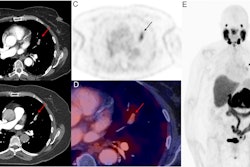How effective is AI for detecting PE on CTPA studies?
The use of an AI triage system to detect any pulmonary embolism (PE) on CT pulmonary angiography (CTPA) studies decreases patient wait times, but it doesn't improve radiologist accuracy, miss rate, or exam and report turnaround times, researchers have found.
The mixed results highlight the need for more research on the use of AI for this indication, wrote a team led by Steven Rothenberg, MD, of the University of Alabama in Birmingham. The study findings were published October 3 in Radiology.
"Future research should … include the integration of AI into the worklist, use larger sample sizes to better assess the miss rate, and incorporate multi-institutional evaluation in different practice settings," the group noted.
Pulmonary embolism can be life-threatening, and prompt diagnosis and treatment are crucial, the researchers noted. CTPA is the current gold standard for diagnosing suspected PE because it is a noninvasive imaging modality, is widely available, and tends to have high accuracy. But there's still room for improvement when it comes to accuracy, miss rates, and exam turnaround times – and AI could help.
To assess the performance of an AI algorithm for improving the diagnosis of pulmonary embolism, Rothenberg and colleagues conducted a study that included 1,436 adults who underwent CTPA exams for suspected PE. The team asked 42 radiologists to evaluate the studies in two phases: 31 without the help of commercially available AI software (Aidoc) and 37 with it, then compared diagnostic accuracy and turnaround times between the two phases.
Phase I of the research included 503 CTPA studies and Phase II included 1,023 studies.
The investigators found that AI cut patient wait times for positive PE studies and decreased the miss rate for detection of clinically insignificant PE, but it did not improve accuracy, miss rate for detection of any PE, or report or interpretation turnaround time.
| Ability to identify pulmonary embolism on CTPA, radiologists reading alone and reading with AI | |||
|---|---|---|---|
| Measure | Radiologist reading alone | Radiologist reading with AI | p-value |
| Mean patient wait time for positive PE studies | 21.5 minutes | 11.3 minutes | < 0.001 |
| Miss rate for detection of clinically insignificant PE | 33% | 14% | 0.04 |
| Accuracy for detection of any PE | 97.6% | 98.6% | 0.15 |
| Miss rate for detection of any PE | 12.3% | 6.1% | 0.11 |
| Report turnaround time | 51.1 minutes | 44 minutes | 0.11 |
| Interpretation time | 27.7 minutes | 31.9 minutes | 0.06 |
AI definitely shows promise for streamlining radiology workflow and improving patient care, but there's more work to be done, wrote David Murphy, MD, and Syer Ree Tee, MD, both of St. Vincent's University Hospital in Dublin, Ireland, in an accompanying commentary.
"In the current era in which the exponential increase in the demand for imaging surpasses the availability of radiologists, AI will hopefully provide a welcome adjunct to the radiology workforce, improving patient care and radiologist productivity," the two noted. "However, the
integration of AI comes with a substantial price tag, and its use must provide sufficient clinical improvement to justify its cost."
The complete study can be found here.




















